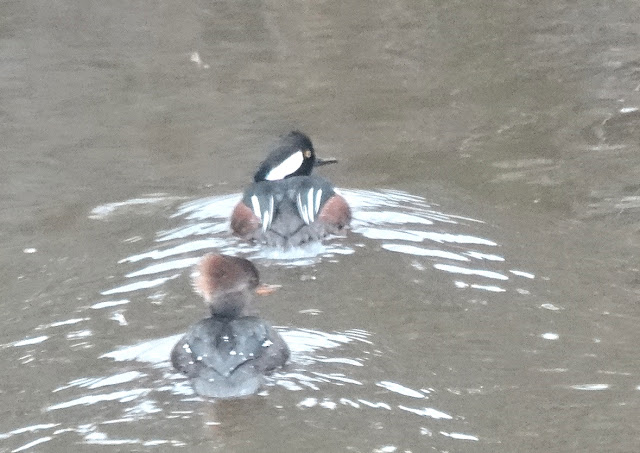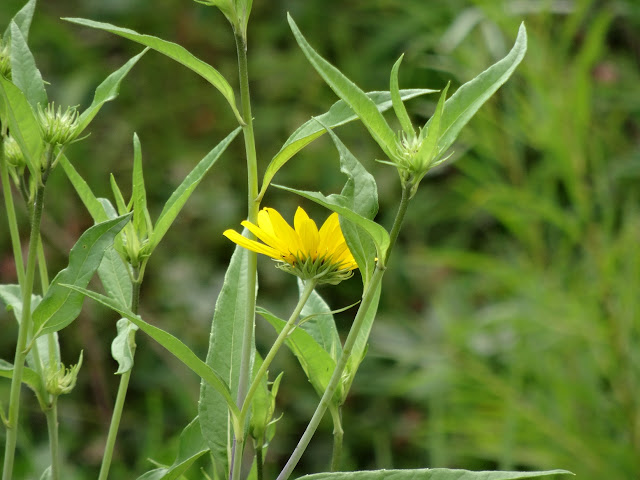4/10/2020
foursome for lunch
We've seen a pair of Hooded Mergansers on the pond each day at various times.
This time, two pairs find lunch on the pond.
They come and go, so probably making the rounds of all the underwater buffets.
We are looking forward to nesting season; this species usually look for a cavity to lay their eggs.
4/08/2020
turtle pile
4/03/2020
bufflehead
Buffleheads Bucephala albeola, small diving ducks, are migrating through Minnesota now. They nest north of here, so I assume these two males stopped today for rest and food. The pond is a perfect place for a respite on a cold snowy day. Maybe they found it warmer under the surface; they seemed to stay under for 12-15 seconds. Judging from the geese and other ducks feeding here, the Buffleheads must be finding nourishment as they dive in the pond. I was trying for a photo of both, but they were constantly diving again, and too quick for me.
3/27/2020
merganser pair
A pair of Hooded Mergansers Lophodytes cucullatus stopped on the pond for a few hours. They are "diving" ducks - - each dives totally under the water to eat vegetation. They also will eat small fish, aquatic insects, crayfish, amphibians, and mollusks. Their eyes are specially adapted to seeing underwater. They locate prey by sight, and propel themselves with their feet. Grasping prey underwater is easy with their long, slender, serrated bill.
3/24/2020
mallards on pond
First mallards this Spring on the pond. They both look healthy and robust, ready for nesting season.
3/14/2020
muskrat on the pond
Muskrat (Ondatra zibethicus) lives in marshes, ponds, and other wet areas. At first, we thought this might be a beaver, but it is only 14 inches long and a rounded 'rat' tail. Muskrats eat roots and stems of wetland plants plus snails, crayfish, fish, frogs.
2/29/2020
Chickadees at feeder over the pond
Black-capped Chickadees stay in Minnesota all winter. They eat seeds and insects or larvae when they can find any. They come to feeders where I offer sunflower seeds, safflower seeds, and peanut chips. This feeder hangs over the pond with an extra branch for the birds to perch on.
From November to April I watch, count, and report the birds I see as a citizen scientist. Cornell Lab of Ornithology is replete with data and information about birds. https://www.birds.cornell.edu/home
This pond is covered with snow, and a layer of ice under that. The turtles are hibernating below in the mud. The muskrats are snug in their burrows. It looks quiet and peaceful on the pond, but there is a lot going on in all seasons.
2/21/2020
snowy pond February
How different the same view looks in winter! Still, we see evidence of critters who live at the pond by their tracks in the snow.
2/10/2020
feeding birds on the pond
Chickadees, house finches, juncos, and even downy woodpeckers venture out of the trees nearby to take seed at the feeder next to the pond.
12/31/2019
winter feeder
The seed feeder hangs on a pole. I attached a forked tree branch so the birds have something to perch on. In this grey winter landscape, it is hard to spot. But the birds find it easily.
11/07/2019
doves
The seed feeder and suet cage are out, filled, and waiting for birds. So far, the only obvious visitors are two Mourning Doves. They sat on the deck rail for a while, warming themselves in the sun.
10/06/2019
10/01/2019
rest stop
Occasionally, Canada Geese land on the pond to feed on pondweed or take a rest during migration. These five stopped for just an hour.
9/05/2019
Ironweed
Tall and graceful on purple stems, Ironweed Vernonia fasciculata blooms in late summer. This clump stands on the western edge of the pond in full sun. It is a host plant for American Painted Lady butterflies, and of value for native bees.
8/28/2019
2019 - FIRST POST FROM WETLANDS
Wetlands will now be included in this blog, since my windows now look out on a pond. My new location is another former farm field that became a neighborhood. Fortunately, the pond was preserved. It is surrounded by wildflowers, grasses, trees, and reeds.
8/18/2018
2018 -- sunflower seeds LAST POST FROM WOODLAND GARDEN
Sunflowers have bloomed, and the seeds are ripe. Usually the Chickadees, with their extreme curiosity, are the first to inspect the seedheads. But the Goldfinches are the true connoisseurs of sunflower seeds fresh from the seedhead. I've noticed they usually hang around on a seedhead for quite a while, and use a horizontal leaf as a shelf to help enjoy the treat.
The scientific name of Sunflowers, Helianthus, is from Helia for "sun" and Anthus for "flower".
8/13/2018
nectar
Monarchs are finding the
Joe Pye Weed and milkweed plants in the yard.
This one even found the sweet nectar in the hummingbird feeder.
6/26/2018
juvenile birds
The wild wild woods and the feeder garden are full of fledgelings and juvenile birds. Some are learning to get suet from the hanging dispensers. This Downy Woodpecker has been at the suet three days in a row. If it is with the same young bird, I suspect she is pretending to be a slow learner so the adult continues to serve it up.
6/25/2018
6/01/2018
5/30/2018
differences
Some birds confuse me! These two often up show in the feeder garden. The female Red-wing Blackbird (top) has a long pointed beak for gleaning cattail seeds in the grassy pond area where they nest. The female Rose-breasted Grosbeak (bottom) has a thicker beak for opening the bigger seeds they prefer. Their male mates are bright and flashy, but these females wear a softly speckled breast and subtle coloring to avoid being noticed as they nest and raise their defenseless chicks. Each has a beak that is best suited for the food they prefer.
5/16/2018
suet for Spring birds
5/15/2018
wrens
Several House Wrens Troglodytes aedon have invaded the wild wild woods.
Only about 4.5 inches long, they are tiny melodious singers in the trees.

But in an effort to please his mate, a male will fill several boxes or tree cavities with small twigs, preventing other species from using those nesting sites.
The female Wren will choose one twig-filled cavity or nestbox and place soft material at the bottom. The twigs create a scaffold that serves as a shield against predators. In her chosen hideaway, she will lay a clutch of eggs.

Only about 4.5 inches long, they are tiny melodious singers in the trees.
But in an effort to please his mate, a male will fill several boxes or tree cavities with small twigs, preventing other species from using those nesting sites.
The female Wren will choose one twig-filled cavity or nestbox and place soft material at the bottom. The twigs create a scaffold that serves as a shield against predators. In her chosen hideaway, she will lay a clutch of eggs.

5/13/2018
Grosbeak
Rosebreasted Grosbeak Pheucticus ludovicianus pair are nesting somewhere nearby in the wild wild woods. The female is dressed in brown-gray camouflage pattern so she can hide her eggs among the trees; the male sports a rose front to contrast with his black and white tuxedo. Both come to the feeder tray for seed. But they won't let me know where their nest is!
Subscribe to:
Posts (Atom)

























